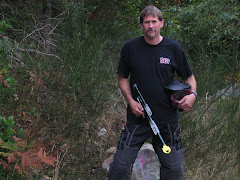Speedball is
the generic name used to describe versions of competitive paintball played on
relatively small, symmetrical fields using air bunkers. The name didn’t exist when players were
competing in the woods. The name implies
that at least one thing in the competition is taking place in a rapid manner.
Admittedly,
my personal involvement with speedball has been fairly limited. By the time I was more seriously involved in
paintball, I was a family man in my late 30’s.
With family commitments and age not being on my side, there was no point
in getting very excited about starting a competitive playing career. But that doesn’t mean I can’t be a fan or put
thought into something so closely linked to the industry I have chosen for
myself.
In a way,
speedball is a lot like the game of Dodge Ball with players trying to eliminate
other players by hitting them with a ball.
The big difference obviously is that in paintball, the balls are
difficult to see and travelling much faster, therefore there is not much
dodging going on, so we need obstacles (bunkers) to hide behind to avoid being
eliminated immediately. The other big
difference is that in Dodge Ball, there is usually only one ball involved,
making the game relatively easy to follow.
Imagine what the game of Doge Ball would be like if there were 5 players
on each team and there were 10 balls in play.
The action would be very difficult to follow.
Speedball is
also a game where the strategy changes as the game is played, much like a game
of chess. Speedball teams may have set
plays for breakouts and may have a few loose plays for when certain things
happen, but in general, the players on the field need to be aware of what is
going on and make decisions on the go.
Chess is like that as well, especially real chess where moves are
limited by time. Here the big difference
is the number of players on each team.
Imagine what would happen if a chess “field” had 5 players on each team
making moves simultaneously. The game
would be completely different and would be impossible for a spectator to
follow. As it is, chess isn’t a very
exciting spectator activity unless you are deeply involved with the activity,
much like paintball.
Whenever I
read one of the threads on forums where people discuss how to “fix” competitive
paintball, one of the first items that pops up in the discussion is that
paintball is difficult to watch. There
are too many things happening at the same time for spectators to keep up. While watching one part of the play,
spectators will most often miss other important moves happening at the same
time. I have watched competitive
paintball many times when the game is over, spectators are turning to one
another and asking, “What happened?”.
With video replays, if enough camera angles exist, this can be somewhat
alleviated, so that spectators (if watching a video version and not live) can
catch up on what they missed. But that’s
still not nearly as good as a sport where spectators can see enough of the action
live that they don’t need video replays to enjoy watching.
The other
thing that comes up in these discussions every time is that paintball is
“boring” to watch. There are too many
times where the risk of moving is much greater than the potential reward,
therefore players will stay in their bunker and fight it out. This most often happens when the number of
players has been reduced, especially when there are only two players left, one
on each team.
The third
thing that comes up is the cost to participate.
Paintball, in most competitive versions, is expensive to take part in,
and most often the cost of paintballs is the accused factor. It’s obvious that all things being equal, a
team with more ammunition has an advantage, therefore to be competitive; teams
must arm themselves with large volumes of paintballs. Teams that want to do well must also
practice. Practice, again, involves
shooting paintballs. Sure you can run
some drills and maybe teams can even do some fitness stuff that doesn’t involve
shooting at all, but when a game is basically about shooting paintballs to
eliminate the other team, it’s difficult to practice without using
paintballs. Even “cheap” paintballs are
a big expense if you need a lot of them, and to be competitive, more is better.
Next week I
will discuss an off the wall solution that can help solve two of the three
major problems associated with competitive paintball with the goal to make the
game more exciting and more affordable without actually changing many rules of
the current competitive paintball game. The
solution is so simple, you’ll wonder why you haven’t thought of it years ago. Although a simple concept, the explanation is
a bit lengthy, so be prepared to set a few minutes aside for it.


No comments:
Post a Comment